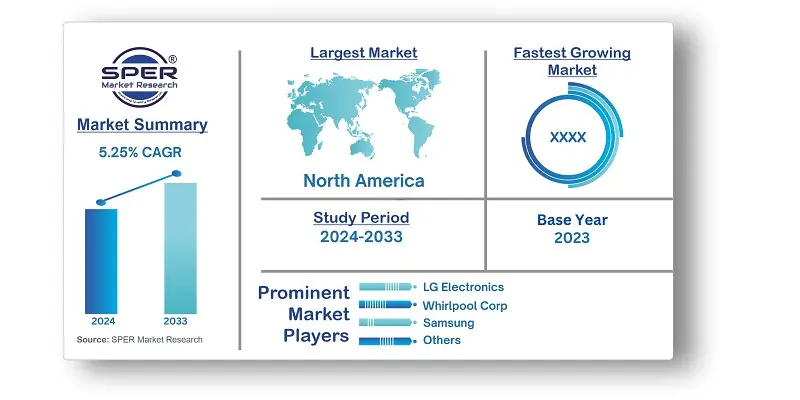
Latin America Home Appliances Market Growth, Size, Trends, Demand, Share and Future Outlook
Latin America Home Appliances Market Size- By Product, By Distribution Channel- Regional Outlook, Competitive Strategies and Segment Forecast to 2033
| Published: Sep-2024 | Report ID: FMCG24155 | Pages: 1 - 157 | Formats*: |
| Category : Consumer & Retail | |||
- June 2023; Mexican air conditioner producer Mirage and IoT development platform service provider Tuya Smart teamed up. Through the development of IoT solutions for the promotion of smarter and greener home appliances, the alliance seeks to produce smart air conditioner products for the Mexican market.
- In April 2023, the Midea Group invested USD 102.29 million to open its third plant in Pouso Alegre, Brazil. With the introduction of the first batch of intelligent refrigerators, the facility will combine cutting-edge science and technology with digital production technologies.


| Report Metric | Details |
| Market size available for years | 2020-2033 |
| Base year considered | 2023 |
| Forecast period | 2024-2033 |
| Segments covered | By Product, By Distribution Channel |
| Regions covered | Brazil, Mexico, Chile, Colombia, Peru |
| Companies Covered | LG Electronics, Whirlpool Corp, AB Electrolux, Samsung, AEG, Bosch, Miele, Groupe SEB, Mabe, Panasonic Corporation. |
- Home Appliance Manufacturers
- Distributors and Retailers
- Investors and Venture Capitalists
- Government Agencies and Policy Makers
- Consumer Electronics and Smart Home Tech Developers
| By Product: |
|
| By Distribution Channel: |
|
- Latin America Home Appliances Market Size (FY’2024-FY’2033)
- Overview of Latin American Home Appliances Market
- Segmentation of Latin America Home Appliances Market by Product (Major Appliances, Small Appliances)
- Segmentation of Latin America Home Appliances Market by Distribution Channel (Multibrand Stores, Exclusive Stores, Online, Other Distribution Channels)
- Statistical Snap of Latin America Home Appliances Market
- Expansion Analysis of Latin America Home Appliances Market
- Problems and Obstacles in Latin America Home Appliances Market
- Competitive Landscape in the Latin America Home Appliances Market
- Impact of COVID-19 and Demonetization on Latin America Home Appliances Market
- Details on Current Investment in Latin America Home Appliances Market
- Competitive Analysis of Latin America Home Appliances Market
- Prominent Players in the Latin America Home Appliances Market
- SWOT Analysis of Latin America Home Appliances Market
- Latin America Home Appliances Market Future Outlook and Projections (FY’2024-FY’2033)
- Recommendations from Analyst
1.1. Scope of the report1.2. Market segment analysis
2.1. Research data source2.1.1. Secondary Data2.1.2. Primary Data2.1.3. SPER’s internal database2.1.4. Premium insight from KOL’s2.2. Market size estimation2.2.1. Top-down and Bottom-up approach2.3. Data triangulation
4.1. Driver, Restraint, Opportunity and Challenges analysis4.1.1. Drivers4.1.2. Restraints4.1.3. Opportunities4.1.4. Challenges4.2. COVID-19 Impacts of the Latin America Home Appliances Market.
5.1. SWOT Analysis5.1.1. Strengths5.1.2. Weaknesses5.1.3. Opportunities5.1.4. Threats5.2. PESTEL Analysis5.2.1. Political Landscape5.2.2. Economic Landscape5.2.3. Social Landscape5.2.4. Technological Landscape5.2.5. Environmental Landscape5.2.6. Legal Landscape5.3. PORTER’s Five Forces5.3.1. Bargaining power of suppliers5.3.2. Bargaining power of buyers5.3.3. Threat of Substitute5.3.4. Threat of new entrant5.3.5. Competitive rivalry5.4. Heat Map Analysis
6.1. Latin America Home Appliances Market Manufacturing Base Distribution, Sales Area, Product Type6.2. Mergers & Acquisitions, Partnerships, Product Launch, and Collaboration in Latin America Home Appliances Market
7.1. Latin America Home Appliances Market Size, Share and Forecast, By Product, 2020-20267.2. Latin America Home Appliances Market Size, Share and Forecast, By Product, 2027-20337.3. Major Appliances7.3.1. Refrigerators7.3.2. Freezers7.3.3. Dishwashing Machines7.3.4. Washing Machines7.3.5. Cookers and Ovens7.3.6. Other Major Appliances7.4. Small Appliances7.4.1. Vacuum Cleaners7.4.2. Food Processors7.4.3. Irons7.4.4. Toasters7.4.5. Grills and Roasters7.4.6. Coffee Machines7.4.7. Hair Dryers7.4.8. Other Small Appliances
8.1. Latin America Home Appliances Market Size, Share and Forecast, By Distribution Channel, 2020-20268.2. Latin America Home Appliances Market Size, Share and Forecast, By Distribution Channel, 2027-20338.3. Multibrand Stores8.4. Exclusive Stores8.5. Online8.6. Other Distribution Channels
9.1. Latin America Home Appliances Size and Market Share
10.1. Latin America Home Appliances Market Size and Market Share By Region (2020-2026)10.2. Latin America Home Appliances Market Size and Market Share By Region (2027-2033)10.2.1. Brazil10.2.2. Mexico10.2.3. Chile10.2.4. Colombia10.2.5. Peru10.2.6. Others
11.1. LG Electronics11.1.1. Company details11.1.2. Financial outlook11.1.3. Product summary11.1.4. Recent developments11.2. Whirlpool Corp11.2.1. Company details11.2.2. Financial outlook11.2.3. Product summary11.2.4. Recent developments11.3. AB Electrolux11.3.1. Company details11.3.2. Financial outlook11.3.3. Product summary11.3.4. Recent developments11.4. Samsung11.4.1. Company details11.4.2. Financial outlook11.4.3. Product summary11.4.4. Recent developments11.5. AEG11.5.1. Company details11.5.2. Financial outlook11.5.3. Product summary11.5.4. Recent developments11.6. Bosch11.6.1. Company details11.6.2. Financial outlook11.6.3. Product summary11.6.4. Recent developments11.7. Miele11.7.1. Company details11.7.2. Financial outlook11.7.3. Product summary11.7.4. Recent developments11.8. Groupe SEB11.8.1. Company details11.8.2. Financial outlook11.8.3. Product summary11.8.4. Recent developments11.9. Mabe11.9.1. Company details11.9.2. Financial outlook11.9.3. Product summary11.9.4. Recent developments11.10. Panasonic Corporation11.10.1. Company details11.10.2. Financial outlook11.10.3. Product summary11.10.4. Recent developments11.11. Others
SPER Market Research’s methodology uses great emphasis on primary research to ensure that the market intelligence insights are up to date, reliable and accurate. Primary interviews are done with players involved in each phase of a supply chain to analyze the market forecasting. The secondary research method is used to help you fully understand how the future markets and the spending patterns look likes.
The report is based on in-depth qualitative and quantitative analysis of the Product Market. The quantitative analysis involves the application of various projection and sampling techniques. The qualitative analysis involves primary interviews, surveys, and vendor briefings. The data gathered as a result of these processes are validated through experts opinion. Our research methodology entails an ideal mixture of primary and secondary initiatives.



Frequently Asked Questions About This Report
PLACE AN ORDER
Year End Discount
Sample Report
Pre-Purchase Inquiry
NEED CUSTOMIZATION?
Request CustomizationCALL OR EMAIL US
100% Secure Payment






Related Reports
Our Global Clients
Our data-driven insights have influenced the strategy of 200+ reputed companies across the globe.




















